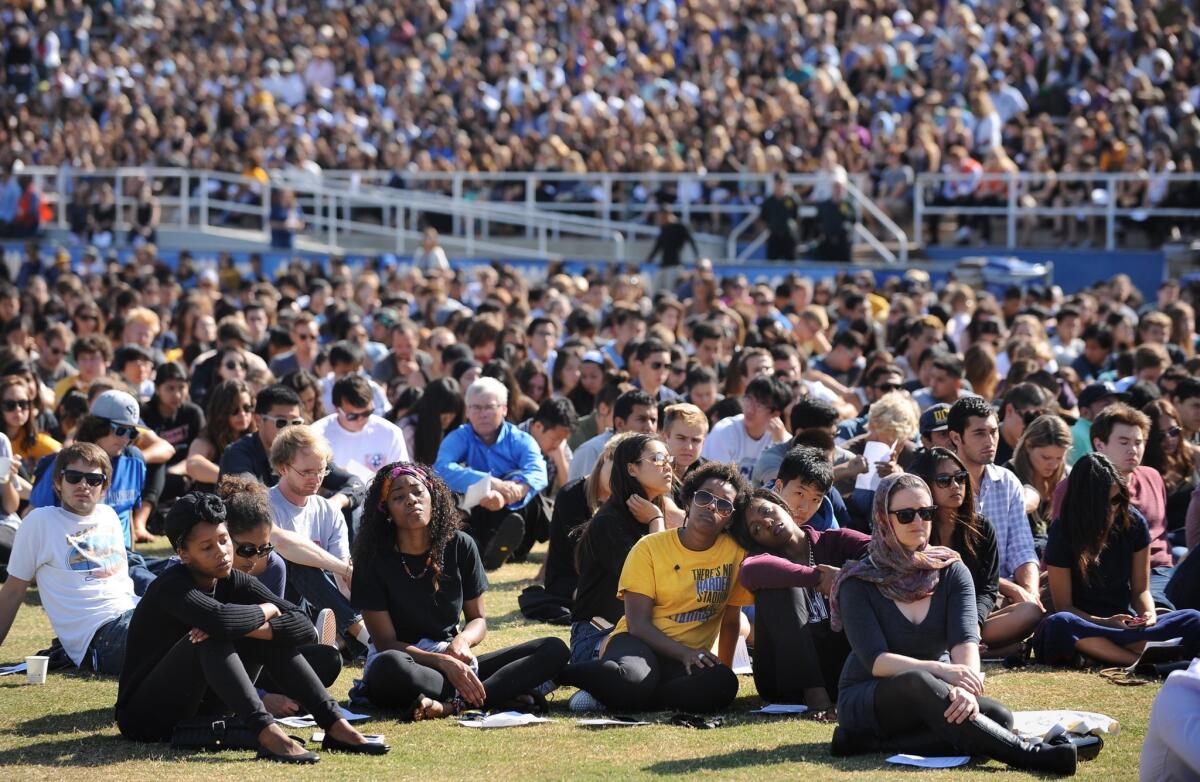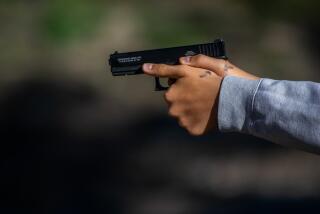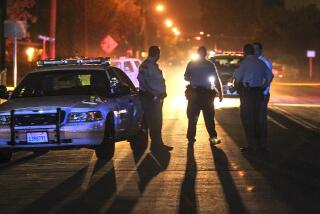Focus on Isla Vista killer is criticized

- Share via
Reporting from ISLA VISTA, Calif. — As he left UC Santa Barbara’s memorial for victims of last week’s rampage Tuesday evening, Matt Moore fumed about the attention being lavished on the man who caused the violence.
Elliot Rodger, 22, left behind videos and writings that vividly describe his life, his anger and his plan to kill people in the college town.
“It makes me sick seeing those videos over and over again,” said Moore, who went to high school with one of the victims, Christopher Michaels-Martinez. “By continuously showing the videos and stuff, you’re putting the limelight on him and not the people he killed.... I want to remember Chris.”
In the long history of mass murder in the U.S., experts could not recall a more personal and minutely detailed explanation of motive than the one Rodger gave. Over the last few days, hundreds of thousands of people have scanned his writings and watched his videos as they try to make sense of the violence.
Academics who study mass murder said the more coverage his screed gets, the more likely other troubled people might see acts of violence as a way to attract similar attention.
“Knowing that people will talk about you afterward is a very important component for these mass murderers,” said Ron Avi Astor, a professor of social work and education at USC. “It’s how they’ll be remembered, and it seems to be an external way their life will have meaning.”
In an autobiography he sent his parents, a therapist and others, Rodger said he was frustrated that he was still a virgin at 22 and wanted revenge against women for rejecting him. He also laid the groundwork for the rampage in which he stabbed and shot six UCSB students before fatally shooting himself.
Rodger’s document is exceptional for its easy-to-follow language and vividly drawn scenes, especially compared with the writings of other notorious figures.
Unabomber Ted Kaczynski’s 35,000-word “Industrial Society and Its Future” was a dense treatise against modern society with sections such as “The Psychology of Modern Leftism.”
Rodger’s “My Twisted World” presents his misogynistic views in the context of an intensely personal autobiography. He recounts blowing out the candles and wearing a wizard hat at his Disney-themed sixth birthday. He remembers seeing a naked woman for the first time in an AOL chat room at age 11. And he describes what it felt like when he began building an arsenal at 21.
“After I picked up the handgun, I brought it back to my room and felt a new sense of power,” he wrote. “I was now armed.”
Roger Shuy, a linguist who consulted with the FBI on the Unabomber case, said that while Rodger’s statements and writings were comparable to Kaczynski’s in anger and volume, the scope was much narrower.
The Unabomber was “full of anger at social structure, economic structure, philosophy in general,” said Shuy, professor emeritus at Georgetown University. “Rodger is just talking about himself and his own little world where he doesn’t get any sex.”
Although mass murderers attempting to express their motivation in writing isn’t new, Northeastern University criminology professor Jack Levin said technology has changed the way that their messages are delivered. In the case of the Virginia Tech shooting in 2007, Seung-Hui Cho went to a post office and mailed videos to NBC, which eventually released them.
“Nowadays young people know enough about the Internet that they can do it themselves,” Levin said. “They can place themselves in a celebrity position without the help of traditional news sources.”
Levin said he worries that Rodger’s collective YouTube confessionals will set a new precedent: mass shooters making detailed videos.
Levin’s colleague James Alan Fox said mass murderers typically leave writings as a form of justification.
“It’s very important [to them] that the world doesn’t view them as some nut that killed for no reason,” said Fox, who has written several books on mass shootings. “In their minds, they are good guys.”
As for the academic importance of the writings, Fox added: “It certainly gives us a very good window into his state of mind. But what’s the value of that? He’s dead.”
And for the families of some victims, having a killer’s detailed justification for his or her acts doesn’t necessarily provide closure.
In the days and weeks after Cho shot her granddaughter to death in French class at Virginia Tech, Catherine Read never thought to watch the seething video he dropped into the mail minutes before the shooting.
“I don’t even think we could have even focused on it,” she recalled Tuesday. “We were in survival mode.”
Seven years have gone by and Read still hasn’t watched the video. She said she knows anything Cho said wouldn’t answer her main question: “Why?”
“It will never make sense,” she said.
In Isla Vista, Tuesday was a day of mourning. About 20,000 people attended an afternoon memorial at Harder Stadium, where UC President Janet Napolitano spoke: “We are grieving together today as a family.”
One of the most emotional moments in the service came when Michaels-Martinez’s father demanded stronger gun-control laws.
“Not one more!” Richard Martinez boomed to the crowd. “Too many people have died, and there should be not one more. How many more people are going to have to die in this situation before the problem gets solved?”
Times staff writers Matt Stevens and Kate Mather contributed to this report.
More to Read
Sign up for Essential California
The most important California stories and recommendations in your inbox every morning.
You may occasionally receive promotional content from the Los Angeles Times.













